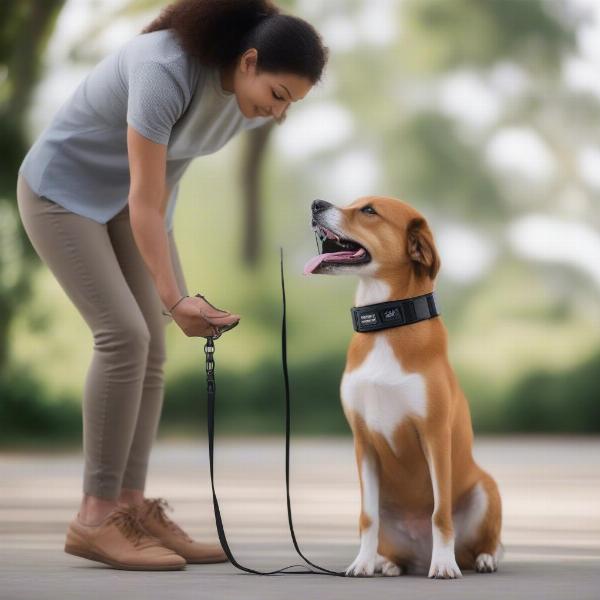No shock vibration dog collars offer a gentle yet effective alternative to traditional shock collars. These collars use vibrations to interrupt unwanted behaviors, providing a humane and safe training experience for your canine companion. They are increasingly popular with dog owners worldwide looking for a kinder approach to training. But are they right for your dog? This comprehensive guide will explore everything you need to know about no shock vibration dog collars, from how they work to choosing the best one for your furry friend.
Understanding No Shock Vibration Dog Collars
How exactly do these collars work? No shock vibration dog collars utilize a small device that emits vibrations when activated. The intensity of the vibration can usually be adjusted to suit your dog’s sensitivity and the specific behavior you’re addressing. Instead of inflicting pain like a shock collar, the vibration acts as a distraction and interrupts the dog’s focus on the unwanted behavior. This allows you to redirect their attention and reinforce positive actions. It’s a more compassionate way to train, focusing on positive reinforcement and discouraging unwanted behaviors without causing discomfort.
The key difference between no shock and shock collars lies in their impact on the dog. Shock collars deliver an electric pulse that can cause pain and fear, potentially leading to negative associations with training. Vibration collars, on the other hand, offer a gentler approach that avoids these negative consequences. This makes them a suitable option for sensitive dogs or those who are new to training.
Choosing the Right No Shock Vibration Dog Collar
Selecting the appropriate no shock vibration dog collar involves considering factors like your dog’s size, temperament, and the specific training goals. For smaller breeds, a lighter and less intense vibration setting might be sufficient, whereas larger or more stubborn dogs may require a more robust collar with stronger vibrations.
Features like adjustable intensity levels, waterproof design, and battery life are important to consider. Some collars even offer multiple training modes, such as beep and vibration, providing more flexibility in your training approach. Look for collars made from durable and comfortable materials that won’t irritate your dog’s skin. A well-fitting collar is crucial for both safety and effectiveness.
Effective Training Techniques with a No Shock Vibration Dog Collar
Using a no shock vibration dog collar effectively involves pairing the vibration with clear commands and consistent training. The vibration serves as a cue to interrupt the unwanted behavior, and you should immediately follow it with a verbal command or hand signal indicating the desired action. For example, if your dog is barking excessively, you might activate the vibration and then say “Quiet.” When the dog stops barking, reward them with praise or a treat to reinforce the positive behavior.
 Training a Dog with a No Shock Vibration Collar
Training a Dog with a No Shock Vibration Collar
Consistency is key to success with any training method. Use the collar consistently during training sessions, and always follow the same pattern of vibration, command, and reward. Avoid overusing the collar, as this can desensitize your dog to the vibrations. Remember, the goal is to teach your dog to respond to your commands, not to rely solely on the collar.
Conclusion
No shock vibration dog collars offer a humane and effective way to train your dog without resorting to painful shocks. By understanding how these collars work and choosing the right one for your dog, you can create a positive and rewarding training experience. Remember to prioritize consistency and positive reinforcement for optimal results. Choosing the right collar and implementing a consistent training plan can help you build a stronger bond with your furry friend while addressing unwanted behaviors effectively.
FAQ
- Are no shock vibration collars safe for all dogs? Generally, yes, but always consult your veterinarian if you have concerns about your dog’s specific health or temperament.
- How long should I use the vibration collar during each training session? Keep sessions short and focused, typically no more than 10-15 minutes at a time.
- What if my dog doesn’t respond to the vibration? Try adjusting the intensity level or consider consulting a professional dog trainer.
- Can I use a vibration collar for puppies? Yes, but choose a collar designed for puppies with gentler vibration settings.
- Are there any potential side effects of using a vibration collar? Some dogs may experience temporary skin irritation if the collar is too tight or worn for extended periods.
- Can a vibration collar help with aggression? While it can be a tool in a comprehensive training plan, consult a professional for addressing aggression.
- How do I choose the right vibration intensity for my dog? Start with the lowest setting and gradually increase until you find a level that gets your dog’s attention without causing distress.
ILM Dog is a leading international website dedicated to providing expert advice and resources on all aspects of dog care and training. From breed selection to health and nutrition, we offer comprehensive and reliable information to help you become the best dog owner you can be. We specialize in providing valuable insights on Dog Breeds and Selection, Training and Behavior, as well as Products and Accessories. For more expert advice, contact our team of experienced dog professionals at [email protected] or call us at +44 20-3965-8624. Visit ILM Dog today for all your dog care needs!